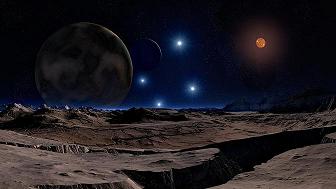In 2014, the same team of astronomers had found two rings around Chariklo, a smaller, space rock orbiting between Neptune and Jupiter.
Haumea—an egg-shaped dwarf planet located at the edge of our Solar System—features a ring of particles, according to a new study led by a group of astronomers from the Institute of Astrophysics of Andalusia.
The discovery has amazed astronomers around the world as they can now expect more such ring-related findings in coming years.
While this is an amazing finding, as per scientists, it is not the first instance of a ring being discovered around a small body like Haumea in our Solar System. In 2014, the same team of astronomers had claimed to have found two rings around Chariklo, a smaller, space rock orbiting between Neptune and Jupiter. The discovery was very surprising for astronomers at that time as only the gas giants in our Solar System were known to have rings up until that point.
Haumea is one of the four dwarf planets in our solar system
Haumea is a strange world located more than 2 billion kilometers beyond Pluto. It has two moons. A few years back, Haumea was officially declared one of the four dwarf planets—other three being Pluto, Eris, and Makemake—orbiting the Sun from beyond the orbit of Neptune. Haumea completes one circle around the Sun in 284 Earth years. It takes just 3 hours and 55 minutes to complete one rotation on its axis; in comparison, Pluto completes one spin in 6.4 Earth days. Astronomers believe huge rotational speed of Haumea has caused it to attain an ellipsoid shape, like a rugby ball.
Stellar occultation
Generally, it is not easy for astronomers to gather information about the objects located beyond Neptune because of their small size and low brightness. The enormous distance between Earth and these objects also poses hindrance in observing them from Earth. Astronomers, therefore, have to rely on a stellar occultation to investigate these objects. Stellar occultation refers to an event in which an object passes in front of a star, allowing researchers to determine the main characteristics (shape, density, and size) of that object. In the past, astronomers have successfully applied this technique to study a large number of celestial objects, including dwarf planets like Eris, Pluto, and Makemake.
Haumea passed in front of a red star on January 21, 2017
On January 21 this year, Haumea passed in front of a red star, named URAT1 533-182543, located in Boötes constellation. This eclipse was observed by 12 telescopes in six countries, allowing scientists to gather additional details about Haumea. The event revealed that this dwarf planet features a 70-km wide ring around its equator, and that the ring is located about 2290 km from Haumea’s centre. Astronomers also found that this small world is actually much bigger than previously thought. It has lower density and reflects lesser amount of light.
The detailed findings of the study were published in Nature.
